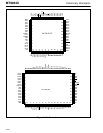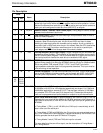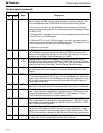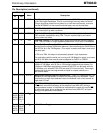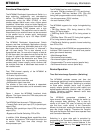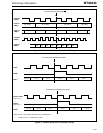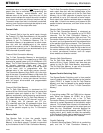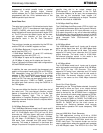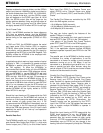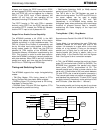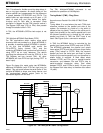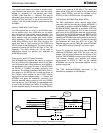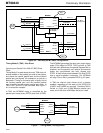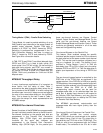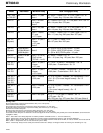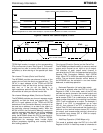
MT90840 Preliminary Information
2-240
Register enables the internal divider, and the SPCKo
output (and internal 4.096 MHz clocks) are driven by
the clock divided-down from PCKR. At 16.384 MHz,
this is a simple divide-by-4, and the SPCKo output
jitter will depend on the PCKR input jitter. At 19.44
MHz, the SPCKo output jitter will be larger as the
divider switches between rising and falling edges of
PCKR. The serial port timing and F0o frame pulse
are tightly slaved to PPFRi when INTCLK is set high.
Serial Frame Pulse
In TM1, the MT90840 receives the frame reference
(F0i) from an external source, and the MT90840
senses the polarity of the frame pulse and adapts the
device timing to the appropriate (ST-BUS or GCI)
format.
In TM2 and TM3, the MT90840 outputs the serial
port frame pulse (F0o). Positive (GCI) or negative
(ST-BUS) frame pulse formats, and the associated
clock polarity, can be selected for the F0o signal by
programming the SPFP bit in the GPM Register. This
flexibility allows the MT90840 to be employed with
different serial bus formats.
In applications which require a large number of serial
channels in TM2, it is possible to operate multiple
MT90840s in parallel using the SFDI control bit (in
the TIM register). To allow the MT90840s to
synchronize their internal timing, all of the MT90840s
are connected to the same C4/8 reference source,
and one MT90840 in normal TM2 (SFDI set low)
supplies F0 to one or more MT90840s in TM2 with
SFDI set high. With SFDI set high, F0 becomes an
input, and this allows the MT90840 driving F0 to
control the timing of one or more other MT90840s. If
the internal 4.096 MHz clock divider is used (INTCLK
high) it is not necessary to use the SFDI control, as
the serial port timing and F0o frame pulse of each
parallel MT90840 will be tightly slaved to PPFRi
when INTCLK is set high.
Should the input framing at F0i cease while the C4/8
clock continues to run, the MT90840 will continue to
function as if the frame pulse was asserted after the
normal number of clock cycles (free run). If F0i
re-commences the MT90840 will immediately sync to
F0i, but changes in the F0i interval will temporarily
disrupt the TDM data streams. If the F0i input is held
asserted, the serial I/O will “lock up” and operation
will be disrupted.
Parallel Data Port
The MT90840 parallel port is composed of an 8-bit
wide Parallel Data Output Port (PDo0-7), a 4-bit wide
Control output port (CTo0-3), an 8-bit wide Parallel
Data Input Port (PDi0-7), a Receive Frame sync
signal (PPFRi) and a Transmit Frame sync signal
(PPFT), and Transmit (PCKT) and Receive (PCKR)
Clocks.
The Parallel Port Rates are controlled by the PPS
bits in the IMS register, and are:
• 19.44 Mbyte/s (2430 channels),
• 16.384 Mbyte/s (2048 channels), and
• 6.48 Mbyte/s (810 channels).
The user can further specify the features of the
parallel TDM port, including:
• the edge of the parallel port clock used to transmit
data and PPFTo (see TCP bit in the TIM register),
• the polarity of the Parallel Port Frame Transmit
pulse PPFT (see PPFP bit in the GPM register),
• the use of PPFT (normally an output) as an input in
TM1, if the application requires multiple MT90840
devices to operate in parallel (see PFDI bit in the TIM
register).
The parallel port of the MT90840 is flexible enough
to interface to a variety of applications. It can be
connected to a framer to access a serial transport
backbone running at up to 155 Mbps. It can be
connected to a backplane-type parallel bus. It can
share a parallel bus with other devices, using the
control outputs (CTo0-3) and the per-channel tristate
function to share access to the bus.
Parallel Port Clock Signals and Framing
The MT90840's PPFRi (Parallel Port Frame pulse
Receive input) and PPFTi/o (Parallel Port Frame
pulse Transmit i/o) signals synchronize the MT90840
to the high speed data frame. Receive data is
clocked in at the Parallel Data inputs (PDi0-7) by the
Parallel port Receive ClocK (PCKR), as framed by
Receive Parallel Port Frame input (PPFRi). In TM2,
TM3 and TM4, PCKR also clocks the Parallel Data
outputs (PDo0-7), with the framing in TM2 and TM4
indicated by the PPFTo output. In TM1, the Parallel
Data outputs are clocked out by PCKT, with the
framing indicated by PPFTo. Alternatively, the
Transmit framing can be controlled by the PPFTi
input if the PFDI bit in the TIM register has been set
high, to enable multiple MT90840s to operate in
parallel in TM1.
Should the input framing at PPFRi cease while the
PCKR clock continues to run, the MT90840 will
continue to function as if the frame pulse was
asserted after the normal number of clock cycles
(free run). If PPFRi re-commences, the MT90840 will
immediately sync to PPFRi, but any change in the
framing interval will temporarily disrupt the TDM data



